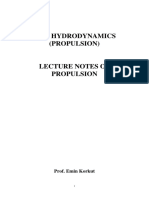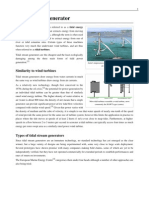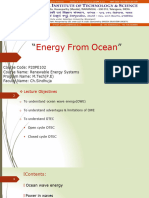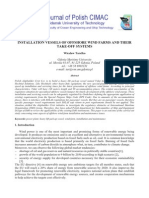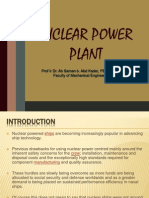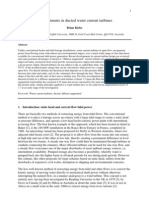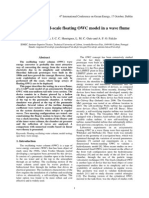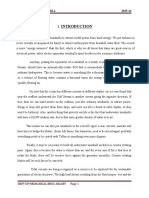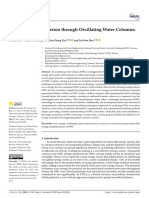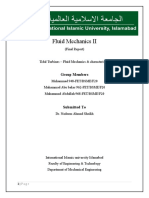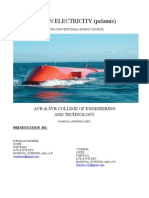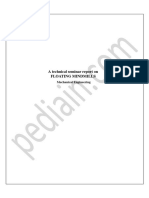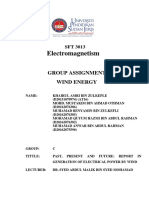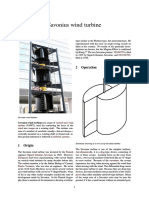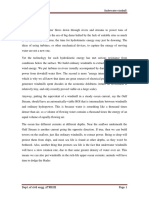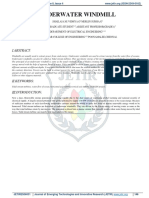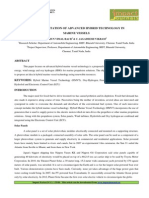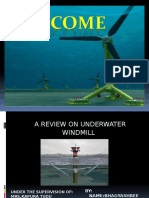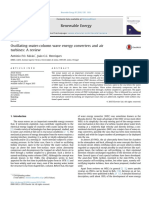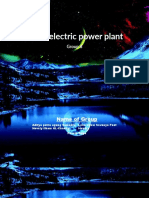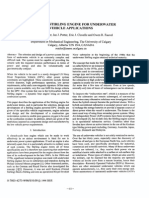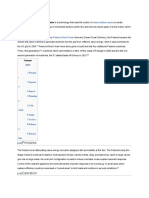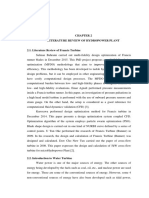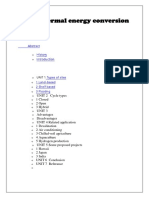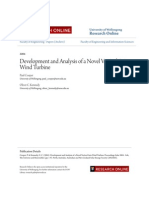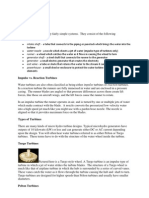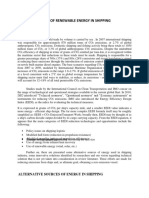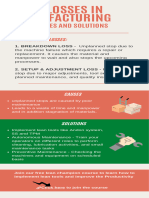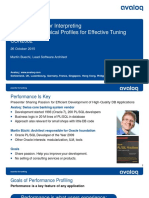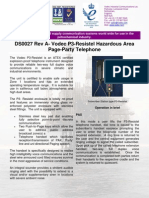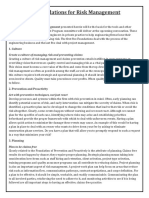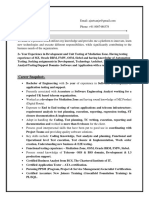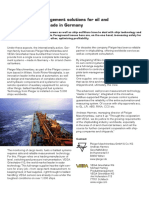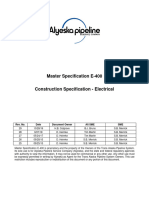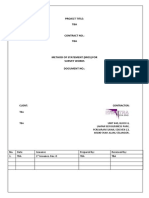A Review of Oscillating Water Columns
A Review of Oscillating Water Columns
Uploaded by
Cristobal Michelangelo FernaandesCopyright:
Available Formats
A Review of Oscillating Water Columns
A Review of Oscillating Water Columns
Uploaded by
Cristobal Michelangelo FernaandesCopyright
Available Formats
Share this document
Did you find this document useful?
Is this content inappropriate?
Copyright:
Available Formats
A Review of Oscillating Water Columns
A Review of Oscillating Water Columns
Uploaded by
Cristobal Michelangelo FernaandesCopyright:
Available Formats
Downloaded from rsta.royalsocietypublishing.
org on October 28, 2012
A review of oscillating water columns
T. V. Heath Phil. Trans. R. Soc. A 2012 370, 235-245 doi: 10.1098/rsta.2011.0164
Subject collections
Articles on similar topics can be found in the following collections ocean engineering (17 articles)
Email alerting service
Receive free email alerts when new articles cite this article - sign up in the box at the top right-hand corner of the article or click here
To subscribe to Phil. Trans. R. Soc. A go to: http://rsta.royalsocietypublishing.org/subscriptions
Downloaded from rsta.royalsocietypublishing.org on October 28, 2012
Phil. Trans. R. Soc. A (2012) 370, 235245 doi:10.1098/rsta.2011.0164
OPINION
PIECE
A review of oscillating water columns
B Y T. V. H EATH*
Voith Hydro Wavegen Ltd, 13A Harbour Road, Inverness IV1 1SY, UK
This paper considers the history of oscillating water column (OWC) systems from whistling buoys to grid-connected power generation systems. The power conversion from the wave resource through to electricity via pneumatic and shaft power is discussed in general terms and with specic reference to Voith Hydro Wavegens land installed marine energy transformer (LIMPET) plant on the Scottish island of Islay and OWC breakwater systems. A report on the progress of other OWC systems and power take-off units under commercial development is given, and the particular challenges faced by OWC developers reviewed.
Keywords: waves, oscillating water columns, marine energy
1. What is an oscillating water column?
The oscillating water column (OWC) concept is probably unique among the myriad systems proposed for extracting power from ocean waves in that it is the only technology where a key part of the system can be seen as a naturally occurring structure. An OWC comprises two key elements: a collector chamber, which takes power from the waves and transfers it to the air within the chamber, and a power take off (PTO) system, which converts the pneumatic power into electricity or some other usable form. The pressure in the collector is alternately pressurized as the water column rises and rareed as the water column falls (gure 1). OWC collectors occur naturally in the form of blow holes. These are common in limestone cliffs, but unfortunately are not usually of an ideal geometry for commercial use (gure 2). The PTO is typically an air turbine (although water pumps have been considered as an alternative) and, for simplicity, the air turbine normally selected is of a self-rectifying form so that whether the collector is exhaling or inhaling, the turbine is driven in the same direction. The most commonly used form of PTO in this application is the Wells turbine/induction generator combination, and the leading exponent of this technology is Voith Hydro Wavegen, which have well over 60 000 grid-connected operating hours from their land installed marine energy transformer (LIMPET) OWC plant on the Scottish island of Islay. Other forms of self-rectifying turbines, most notably the impulse machines of Dresser-Rand
*tom.heath@wavegen.com One contribution of 18 to a Theo Murphy Meeting Issue The peaks and troughs of wave energy: the dreams and the reality.
235
This journal is 2011 The Royal Society
Downloaded from rsta.royalsocietypublishing.org on October 28, 2012
236
(a) wave crest air flow
T. V. Heath
(b) wave trough air flow
rising water column
falling water column
Figure 1. Principle of OWC action. (Online version in colour.)
Figure 2. Blowhole at Quobba Western Australia. Reproduced with permission from Crikey Tours. (Online version in colour.)
and Oceanlinx, are also under development. The manufacturers claim that these machines offer a higher conversion efciency than a Wells turbine, but there is no publically available information to demonstrate in real sea conditions and with an appropriate control strategy that the newer designs can match either the performance or the reliability of the turbines in 10 years continuous operation at LIMPET.
2. The attraction of oscillating water columns
The attraction of the OWC concept with an air turbine stems from its simplicity. On a practical level: there are very few moving parts; there are no moving parts in the water;
Phil. Trans. R. Soc. A (2012)
Downloaded from rsta.royalsocietypublishing.org on October 28, 2012
Opinion piece. Oscillating water columns
237
the concept is adaptable and can be used on a range of collector forms situated on the coastline, in the nearshore region or oating offshore; the use of an air turbine eliminates the need for gearboxes; it is reliable; it is easy to maintain; and it uses sea space efciently. The ability to apply the OWC concept in different locations and on different collector platforms is important in that it allows for a gradual development of the technology. Voith Hydro Wavegens shoreline LIMPET plant on Islay allows for the development of the PTO unit under real conditions in an accessible location. The simultaneous development for deep water application of oating units, moorings, umbilicals and PTO systems can be beyond the resources of technology development companies. By building the LIMPET unit and then focusing on the PTO system, Voith Hydro Wavegen is now able to demonstrate availabilities in excess of 95 per cent and have a PTO suitable for application on OWCs in any location.
3. History
The earliest recorded application of an OWC is the whistling buoy used as a navigation aid. As an audible warning device, it was seen in the nineteenth century as a successor to the traditional bell buoys. J. M. Courtney of New York patented such a whistling buoy (gure 3) and in 1885, it was reported in Scientic American that there were 34 operating along the coast of the USA. It was over half a century before the next signicant development in wave power, and again this occurred in the eld of navigation buoys in 1947 when Masuda, in Japan, designed and installed the rst OWC driving an impulse turbine to produce electricity. The unit was sited in Osaka Bay and the electricity generated powered navigation lights. Security of operation was provided by rechargeable batteries that took their power from the turbine/generator in times of plenty. A commercial range of buoys was developed from this original and are available today from the Ryokuseisha company of Japan. While the output of each unit is small at 70500 W, this application still represents the most common application of a wave energy plant. Figure 4 shows the Uraga light buoy tted with four wave-activated turbine generators. Between 1976 and 1979, a team operating under the auspices of the International Energy Agency tested the OWC units mounted on a oating barge, the Kaimei. The 800 tonne 80 m long barge was moored off the coast of Yura, Tsuruoka City, Yamagata Prefecture. With Japan as the lead national partner, there were contributions from the UK, Canada, Ireland and the USA. Eight OWC chambers were mounted in the barge, each with a nominal 125 kW rating. A range of PTO units were tested, including the self-rectifying Wells and McCormick turbines and more conventional turbine systems using rectication valves. During the 1980s and 1990s, a number of shoreline and shore-connected OWCs were built and tested, including a number in Japan, India, China, Norway, Portugal and Britain. The largest of those built in Japan was the port of Sakata. The ve chambered OWC was built as part of a harbour wall. It is a concrete
Phil. Trans. R. Soc. A (2012)
Downloaded from rsta.royalsocietypublishing.org on October 28, 2012
238
T. V. Heath
Figure 3. Courtneys whistling buoy.
Figure 4. Uraga light buoy Tokyo Bay. Reproduced with permission from Ryokuseisha. (Online version in colour.)
caisson structure that was oated into position before being sunk and lled with ballast. The machine, which became operational in 1989, is tted with a tandem Wells turbine. The original rating of the plant was 60 kW. A single turbine 75 kW unit was built by Queens University Belfast on Islay (gure 5).
Phil. Trans. R. Soc. A (2012)
Downloaded from rsta.royalsocietypublishing.org on October 28, 2012
Opinion piece. Oscillating water columns
239
Figure 5. Queens University Belfast 75 kW demonstrator on Islay. (Online version in colour.)
Figure 6. Voith Hydro Wavegen LIMPET OWC. (Online version in colour.)
This grid-connected plant was operated between 1991 and 2000 before being decommissioned and the site returned to nature. The turbine from this plant was recently restored and is now on display at the Deutcshes Museum in Munich. As a follow-on to the Islay prototype, the team at Queens designed the LIMPET plant for construction near to the original plant. Whereas the prototype was in a relatively sheltered gully, the LIMPET plant (originally rated at 500 kW) was facing south westerly towards the teeth of the Atlantic gales. This plant has been in operation since late 2000. The original turbine system has been replaced; the plant is now used as a continuous test bed for the turbine designs to be used in Voith Hydro Wavegens commercial projects with over 60 000 turbine running hours logged to date (gures 68). There is little published information on the performance of air-turbine-based PTO systems for OWC collectors, and it is important to note that success of the system will depend on a good turbine design, an effective control strategy and the matching of the turbine to the OWC collector to ensure efcient collector operation. It is interesting to note that the size of a turbine will often be determined by the requirement for collector matching rather than the ability of the machine to absorb the power from the collector. An example of the energy conversion efciency of the 1.25 m diameter Wavegen turbine shown in gure 8 and measured in irregular seas at LIMPET is shown in gure 9. The pneumatic
Phil. Trans. R. Soc. A (2012)
Downloaded from rsta.royalsocietypublishing.org on October 28, 2012
240
T. V. Heath
Figure 7. Voith Hydro Wavegen RT1 Turbine at LIMPET (18.5 kW). (Online version in colour.)
Figure 8. Ofcial start of Voith Hydro Wavegen RT2 turbine at LIMPET (110 kW). (Online version in colour.)
power ow was measured as the product of chamber pressure and ow through the turbine, while the electrical power was recorded at the input to the generator frequency converter. Each point on this chart represents a 5 min average of the pneumatic power owing through the turbine and electrical power delivered to the frequency converter. The dataset represents over 400 h of operation. The marginal efciency of conversion in low to moderate seas is 60 per cent. A programme of improvements is in process to further improve this performance. The conversion efciencies shown in gure 9 represent a very signicant improvement on previously published data for Wells turbines, and are the product of cooperative development between Voith Hydro Wavegen and the universities of Stuttgart and Siegen in Germany, together with control systems development at Wavegen. The turbine blades and the associated xed stators are the product of a self-optimizing design analysis developed by the university teams followed by computational uid dynamics and laboratory testing [13]. The efcacy of this work is borne out by the eld measurements. The efciency of the turbine will be inuenced by the regularity of the incident waves. The incident resource at LIMPET is not measured directly, but the ratio of the peak chamber pressure to the r.m.s. over a 15 min spectrum is typically in
Phil. Trans. R. Soc. A (2012)
Downloaded from rsta.royalsocietypublishing.org on October 28, 2012
Opinion piece. Oscillating water columns
100 90 80 70 60 50 40 30 20 10 0 50
241
electric power (kW)
RT2D 100 150 200 pneumatic power (kW) 250
Figure 9. Pneumaticelectric conversion of Wavegen PTO. (Online version in colour.)
the range of 56. Waves in the LIMPET gully are signicantly inuenced by the shallow water at the LIMPET site (46 m dependent on tidal height). At the same time as the LIMPET development, a 400 kW OWC was built by Electricidade dos Aores on the island of Pico. This plant is now operated intermittently by the Wave Energy Centre and provides important data for ongoing OWC development. While Voith Hydro Wavegen has focused on proving PTO performance and reliability prior to deployment in ever more challenging locations, other developers in the OWC eld have adopted different development strategies. In conjunction with the University of Craneld, Dresser-Rand has developed a variable radius turbine for use and has tested the unit in an alternating ow. In Ireland, Ocean Energy has developed the backward bent ducted buoy concept originally proposed by Masuda, and the hull has over 20 000 h of live sea trials at the quarter scale. Figures 10 and 11 show the unit at the wave energy test site at Spiddal in Galway in Ireland. There it was subjected to a wide range of wave conditions, including a severe storm when wind speeds reached 2530 m s1 and a wave height of 8.2 m was recorded. For some of the test period, a Wells turbine system developed in Ireland for Ocean Energy was tted to the buoy. During the testing, the airows and power output from the tests scaled up predictably, and the hull behaviour was also consistent and reliable. An alternative design of oating OWC has been developed by Oceanlinx. Their most recent OWC deployment involved its MK3 oating device. The unit (gure 12) is a one-third scale demonstration version of the 2.5 MW full-scale device. It was installed offshore from the eastern breakwater of Port Kembla Harbour from February to May 2010. The unit was grid connected, and supplied electrical power directly into the grid of local retailer, Integral Energy. Returning to the nearshore, Voith Hydro Wavegen is partnering utilities in two pivotal projects; pivotal because they both represent signicant steps in taking wave power systems from single test units towards full-scale commerciality. The rst of these is at Mutriku in the Pas Vasco of northern Spain, where the energy authority Ente Vasco Energia (EVE) is developing an OWC breakwater using Voith Hydro Wavegen PTO technology. The project, which has been delayed for 2 years as a consequence of planning delays and civil engineering
Phil. Trans. R. Soc. A (2012)
Downloaded from rsta.royalsocietypublishing.org on October 28, 2012
242
T. V. Heath
Ocean Energy
17 Jan 2009 13.06.08
Figure 10. Ocean Energy buoy in storm. Reproduced with permission from Ocean Energy. (Online version in colour.)
Figure 11. Ocean Energy buoy with Wells turbine. Reproduced with permission from Ocean Energy. (Online version in colour.)
Figure 12. Mk3 Oceanlinx wave energy generator. Reproduced with permission from Oceanlinx. (Online version in colour.)
Phil. Trans. R. Soc. A (2012)
Downloaded from rsta.royalsocietypublishing.org on October 28, 2012
Opinion piece. Oscillating water columns
243
Figure 13. Mutriku breakwater including 16 OWC chambers. (Online version in colour.)
Figure 14. Section through Mutriku breakwater. Reproduced with permission from the Basque Government Port Department.
problems was commissioned in spring 2011. It is signicant in that the 16 units forming the OWC breakwater section (gures 13 and 14) represent the rst multiple oscillating water column (MOWC) plant offering the opportunity for studying the interaction of the units and the complexities of multiple control. The research and monitoring activities associated with the plant are supported under the European Union FP6 Nereida project. Voith Hydro Wavegen is also providing the technology for a project at Siadar on the north west coast of Lewis in Scotland. Here, it is planned to build a shoreconnected breakwater comprising 15 OWC cells, each tted with two Wavegen 132 kW turbo-generation units giving a nominal rating of 4 MW. This plant is ground breaking in that it will be the rst breakwater built as a power station rather than as an addition to an already planned breakwater. While there will be considerable community benets in that the scheme will provide a sheltered slipway, these benets are secondary to power generation. It is also the rst
Phil. Trans. R. Soc. A (2012)
Downloaded from rsta.royalsocietypublishing.org on October 28, 2012
244
T. V. Heath
Figure 15. Photomontage of Siadar breakwater. Reproduced with permission from the Basque Government Port Department. (Online version in colour.)
wave power plant where the plant output will have the potential to have a major inuence on the local grid, and as such, power quality issues become very important. For this reason, power storage and associated power quality control software are included in the scheme.
4. The future challenge
With 10 years operational experience and over 60 000 turbine running hours, LIMPET has demonstrated that Voith Hydro Wavegen has a reliable generation system ready for widespread application. The Mutriku and Siadar projects are the rst multiple applications of the technology. Other companies are developing new platforms and PTO systems. If the technology is available and effective, then one has to ask the question why there has not been a greater uptake. The answer is quite simple; while OWC technology is effective, it is not yet cost effective (gure 15). There are good reasons why this is so: projects are small so that project costs are disproportionately high; small volumes mean high equipment costs; and weak grids at suitable coastal sites mean high connection charges. The challenge to the industry is to reach the point where these conditions no longer apply and the industry is truly commercial. The problem has been recognized by interested governments, and in Scotland and Portugal, in particular, there are high-support tariffs for wave-generated electricity. The Siadar project could not be considered without the Scottish governments support mechanism via multiple renewable obligation certicates and targeted grants. In the rest of the UK, the marine renewable proving fund and the marine renewable deployment fund are helping to promote ocean energy. Industry cannot rely on disproportionate funding support indenitely and must improve the basic competitiveness of wave energy. This can only be done by reducing costs and improving capture and conversion efciencies. To this end, Voith Hydro Wavegen expects to reduce the effective cost of wave-generated power by 50 per cent within the next 5 years, and other companies must meet the same challenge.
5. Conclusion
As a concept, the OWC is probably the most studied and the best developed of all systems. In shore-based operation, it has demonstrated the reliability necessary
Phil. Trans. R. Soc. A (2012)
Downloaded from rsta.royalsocietypublishing.org on October 28, 2012
Opinion piece. Oscillating water columns
245
for a viable plant, and there is no reason to believe that this reliability cannot be transferred to other platforms. While not specic to OWC systems, the major limitation to the uptake of wave power generators in commercial operation is the cost of power; this is being addressed. The combination of early stage public support and the commitment from industry to improve competitiveness suggest that OWCs will be part of the future mix of generation.
References
1 Starzmann, R., Carolus, T., Tease, K. & Arlitt, R. 2011 Wells turbine rotors: a comparison of the predicted and measured aerodynamic performance. In Proc. 9th European Turbomachinery Conf., Istanbul, Turkey, pp. 10851095. 2 Starzmann, R., Carolus, T., Tease, K. & Arlitt, R. 2011 Effect of design parameters on aeroacoustic and aerodynamic performance of Wells turbines. In Proc. ASME 2011 30th Int. Conf. on Ocean, Offshore and Arctic Engineering, Rotterdam, Netherlands, OMAE2011-49127. 3 Starzmann, R., Moisel, C., Carolus, T., Tease, K. & Arlitt, R. 2011 Assessment method of sound radiated by cyclically operating Wells turbines. In Proc. 9th European Wave and Tidal Energy Conf., Southampton, UK.
Phil. Trans. R. Soc. A (2012)
You might also like
- Fordnh ShibauraDocument5 pagesFordnh Shibauramarani_rahmatNo ratings yet
- Ship Hydrodynamics - Lecture - Notes - Part - 1 - Modern - Propulsion - SystemsDocument9 pagesShip Hydrodynamics - Lecture - Notes - Part - 1 - Modern - Propulsion - SystemsOdpewğw RlelelwNo ratings yet
- A New PetrolDocument9 pagesA New PetrolMariano Escobar AvilaNo ratings yet
- LNG 17 Delegate List 22 FebDocument16 pagesLNG 17 Delegate List 22 Febbenjaminjoseph2001No ratings yet
- Amazon PlanningDocument18 pagesAmazon PlanningMohan RajendaranNo ratings yet
- WaveenergyscanDocument14 pagesWaveenergyscanChersey DoctorNo ratings yet
- Oscillating Water ColumnDocument4 pagesOscillating Water ColumnMuchlis NurdiyantoNo ratings yet
- Ship Hydrodynamics Lecture Notes Part 1 Modern Propulsion SystDocument9 pagesShip Hydrodynamics Lecture Notes Part 1 Modern Propulsion Systtruva_kissNo ratings yet
- Tidal Stream Generator: Similarity To Wind TurbinesDocument8 pagesTidal Stream Generator: Similarity To Wind TurbinesSatyanag VenishettyNo ratings yet
- Tidal Stream Generator-2017Document11 pagesTidal Stream Generator-2017ZerotheoryNo ratings yet
- Steerable Propulsion Units Hydrodynamic Issues andDocument16 pagesSteerable Propulsion Units Hydrodynamic Issues andMaciej ReichelNo ratings yet
- Document Floating Power StatonDocument7 pagesDocument Floating Power Statonajay kumar royNo ratings yet
- The Construction of Oyster - A Nearshore Surging Wave Energy ConverterDocument7 pagesThe Construction of Oyster - A Nearshore Surging Wave Energy ConverterJasmeet Singh Loyal100% (1)
- Renewable EnergyDocument14 pagesRenewable EnergyMounikaNo ratings yet
- Electricity Generating Device Through Wave Oscillation: (Review of Related Literature)Document5 pagesElectricity Generating Device Through Wave Oscillation: (Review of Related Literature)Jazz DungaranNo ratings yet
- 2017-Design Enhancement of An Oscillating Water ColumnDocument8 pages2017-Design Enhancement of An Oscillating Water ColumnUmer MajeedNo ratings yet
- UNITEN ICEE 2006 Prospects For Ocean Energy in MalaysiaDocument7 pagesUNITEN ICEE 2006 Prospects For Ocean Energy in MalaysiaMohd RashdanNo ratings yet
- Floating Wind Turbine - WikipediaDocument21 pagesFloating Wind Turbine - WikipediavineeshNo ratings yet
- Hello HElloDocument8 pagesHello HElloArslan NaveedNo ratings yet
- Wave Power: Presented By: Group - IvDocument16 pagesWave Power: Presented By: Group - IvKIRAN GOPAL100% (1)
- Mtechres PPT U 3 C 3Document15 pagesMtechres PPT U 3 C 3MounikaNo ratings yet
- Installation Vessels of Offshore Wind Farms and Their Take-Off SystemsDocument12 pagesInstallation Vessels of Offshore Wind Farms and Their Take-Off SystemsPriscila KImNo ratings yet
- Nuclear Power PlantDocument21 pagesNuclear Power PlantakusuperNo ratings yet
- Floating Offshore Wind TurbinesDocument24 pagesFloating Offshore Wind TurbinesAbdeldjalil Achour100% (1)
- Developments in Ducted Water Current Turbines: Brian KirkeDocument12 pagesDevelopments in Ducted Water Current Turbines: Brian KirkeMiguel Castro RamosNo ratings yet
- Rui Gomes Idmec IstDocument7 pagesRui Gomes Idmec IstSree Jith SNo ratings yet
- Fdocuments - in - Underwater Windmill ReportDocument21 pagesFdocuments - in - Underwater Windmill ReportChanduNo ratings yet
- Under Water WindmillDocument23 pagesUnder Water Windmillapi-343773957100% (2)
- Jmse 12 00342 v2Document22 pagesJmse 12 00342 v2jacaro6804No ratings yet
- FM2 ReportDocument14 pagesFM2 ReportNasreen ClothNo ratings yet
- Ocean ElectricityDocument11 pagesOcean ElectricityMadhu NaaniNo ratings yet
- A Technical Seminar Report On Floating Mindmills: Mechanical EngineeringDocument31 pagesA Technical Seminar Report On Floating Mindmills: Mechanical Engineeringswati dilip jaybhayeNo ratings yet
- Ocean Wave EnergyDocument11 pagesOcean Wave EnergyJohn AlexisNo ratings yet
- Wind CompilationDocument31 pagesWind CompilationMohd. Mustakim Bin Ahmad OthmanNo ratings yet
- Savonius Wind TurbineDocument4 pagesSavonius Wind TurbineCarlos Castillo PalmaNo ratings yet
- Turbinas 2Document10 pagesTurbinas 2joravicaNo ratings yet
- Seminar ReportDocument15 pagesSeminar ReportMahesh gpNo ratings yet
- Main JournalDocument10 pagesMain JournalHOW ISNo ratings yet
- Underwater Windmill: A Seminar Report OnDocument50 pagesUnderwater Windmill: A Seminar Report OnaaronNo ratings yet
- Eng-An Implementation of Advanced Hybrid Technology-Arjun Vimal Raj RDocument8 pagesEng-An Implementation of Advanced Hybrid Technology-Arjun Vimal Raj RImpact JournalsNo ratings yet
- BorgMColluMBrennanFP MORE2012Document14 pagesBorgMColluMBrennanFP MORE2012s302922No ratings yet
- Design ArgallDocument15 pagesDesign ArgallXa MauNo ratings yet
- Underwater WindmillDocument21 pagesUnderwater Windmillbhagyashree behera100% (1)
- 4942 PDFDocument34 pages4942 PDFSravan GundamNo ratings yet
- B.Inggris Kelompok 8Document15 pagesB.Inggris Kelompok 8Agustinus GiyaiNo ratings yet
- Low Power Stirling Engine For UnderwaterDocument6 pagesLow Power Stirling Engine For UnderwaterVladimirDvortsovNo ratings yet
- Principles: Ocean Surface WavesDocument6 pagesPrinciples: Ocean Surface WavesShipra SharmaNo ratings yet
- Windfloat: A Floating Foundation For Offshore Wind Turbines: Articles You May Be Interested inDocument35 pagesWindfloat: A Floating Foundation For Offshore Wind Turbines: Articles You May Be Interested injeremytoh89No ratings yet
- Underwater Windmill Seminar ReportDocument37 pagesUnderwater Windmill Seminar ReportPappu Mala33% (3)
- 11.2 Chapter 2 FinalDocument19 pages11.2 Chapter 2 FinalPhoo PhooNo ratings yet
- Ocean Thermal Energy Conversion: HistoryDocument20 pagesOcean Thermal Energy Conversion: HistorySantosh PNo ratings yet
- Development and Analysis of A Novel Vertical Axis PDFDocument10 pagesDevelopment and Analysis of A Novel Vertical Axis PDFrahpooye313No ratings yet
- 01 - Hydroelectric PPDocument5 pages01 - Hydroelectric PPSweta MorabiyaNo ratings yet
- Hwang Et Al - 2009 - Optimization of Cycloidal Water Turbine and The Performance Improvement byDocument9 pagesHwang Et Al - 2009 - Optimization of Cycloidal Water Turbine and The Performance Improvement byJalcamNo ratings yet
- Hydraulic Ram-2017 - PDF RoomDocument7 pagesHydraulic Ram-2017 - PDF RoomR Nandhan 3BNo ratings yet
- Water Turbines: TurbineDocument22 pagesWater Turbines: TurbineEr Eklovya SainiNo ratings yet
- Underwater WindmillDocument16 pagesUnderwater WindmillApoorva Kulkarni100% (5)
- Tidal Energy: - A PrimerDocument13 pagesTidal Energy: - A PrimerAlexander WijesooriyaNo ratings yet
- Tidal Power The Future Wave of Power Generation: K.Kesava ReddyDocument14 pagesTidal Power The Future Wave of Power Generation: K.Kesava ReddytslnarayanaNo ratings yet
- Renewable Energy Sources in ShippingDocument7 pagesRenewable Energy Sources in ShippingAnonymous e3ceN15No ratings yet
- Development of Small Scale Wave Energy Converter Using Oscillating Water Column OWC With Power Management SystemDocument13 pagesDevelopment of Small Scale Wave Energy Converter Using Oscillating Water Column OWC With Power Management SystemCarlos Miguel DacaimatNo ratings yet
- Appendix. 17 Tidal Power FW FGDocument16 pagesAppendix. 17 Tidal Power FW FGelliottcbutlerNo ratings yet
- From T-2 to Supertanker: Development of the Oil Tanker, 1940 - 2000, RevisedFrom EverandFrom T-2 to Supertanker: Development of the Oil Tanker, 1940 - 2000, RevisedNo ratings yet
- With TM 8.0: Eric Osterroth Product Unit Transportation & Logistics On-Premise Suite September 29, 2010Document35 pagesWith TM 8.0: Eric Osterroth Product Unit Transportation & Logistics On-Premise Suite September 29, 2010sivaiahchowdaryNo ratings yet
- Sodium Borohydride Fuel Cell AVRCDocument25 pagesSodium Borohydride Fuel Cell AVRCSriharsha GaniNo ratings yet
- From Digital Tools To Manufactured Components: Data Driven InfrastructureDocument62 pagesFrom Digital Tools To Manufactured Components: Data Driven InfrastructurevabsNo ratings yet
- 6 Big Losses in Manufacturing 1679159579Document3 pages6 Big Losses in Manufacturing 1679159579d6x9zxjdpxNo ratings yet
- PLSQL Hierarchical Profiles For Effective TuningDocument47 pagesPLSQL Hierarchical Profiles For Effective TuningDaniel Cabarcas M.0% (1)
- BPO Industry Facing The ChallengesDocument19 pagesBPO Industry Facing The Challengesjohnrichardjasmine0% (1)
- Брошюра по кронблокам и блокам GOSAN для буровых платформDocument9 pagesБрошюра по кронблокам и блокам GOSAN для буровых платформAldika KurniawanNo ratings yet
- DS0027 Rev A - Vodec P3-Resistel Hazardous Area Page-Party TelephoneDocument4 pagesDS0027 Rev A - Vodec P3-Resistel Hazardous Area Page-Party Telephonesalic2013No ratings yet
- CleanTech Ireland Directory-2010Document318 pagesCleanTech Ireland Directory-2010Álvaro GilNo ratings yet
- Ir 211 WK 12 SampleDocument9 pagesIr 211 WK 12 SampleAMIT AMBRENo ratings yet
- Attachment #2 26071-203-V1A-MWB0-00003 - 002 - Sub Vendor ListDocument21 pagesAttachment #2 26071-203-V1A-MWB0-00003 - 002 - Sub Vendor ListMingyu SongNo ratings yet
- 10 Foundations For Risk ManagementDocument4 pages10 Foundations For Risk Management8790922772No ratings yet
- Ajeet Singh - ResumeDocument4 pagesAjeet Singh - ResumeTaslimNo ratings yet
- Polypropylene Product Finder Ap enDocument2 pagesPolypropylene Product Finder Ap enLeductoan LeNo ratings yet
- Vintage Airplane - Jan 1998Document36 pagesVintage Airplane - Jan 1998Aviation/Space History LibraryNo ratings yet
- RTDB (Type-1) For Cooling Bed AreaDocument9 pagesRTDB (Type-1) For Cooling Bed AreaHimanshu RaiNo ratings yet
- Complete Tank Management Solutions For Oil and Chemical Tankers - Made in GermanyDocument1 pageComplete Tank Management Solutions For Oil and Chemical Tankers - Made in GermanyPamellaNo ratings yet
- Port Stanley Harbour Feasibility Study Business Plan - FINAL - October 27, 2009Document54 pagesPort Stanley Harbour Feasibility Study Business Plan - FINAL - October 27, 2009The London Free Press100% (4)
- Piping Manhour Costing Estimate SampleDocument24 pagesPiping Manhour Costing Estimate SampleMethosalem Haincadto83% (35)
- E-400 - Construction Specification - ElectricalDocument82 pagesE-400 - Construction Specification - ElectricalDinesh RajNo ratings yet
- Intranet and ExtranetDocument11 pagesIntranet and ExtranetShashank ParmarNo ratings yet
- Resume Ajeet KumarDocument2 pagesResume Ajeet KumarEr Suraj KumarNo ratings yet
- Project Title: TBA: Client: ContractorDocument3 pagesProject Title: TBA: Client: ContractorIzza HalimNo ratings yet
- Steel Pipes Standard SizesDocument2 pagesSteel Pipes Standard SizesCarolie BacatanoNo ratings yet
- Power Point Slides To Chapter 01Document29 pagesPower Point Slides To Chapter 01Satya Sri ONo ratings yet
- Gadang - Annual Report 2018 PDFDocument284 pagesGadang - Annual Report 2018 PDFMohd FazlanNo ratings yet

